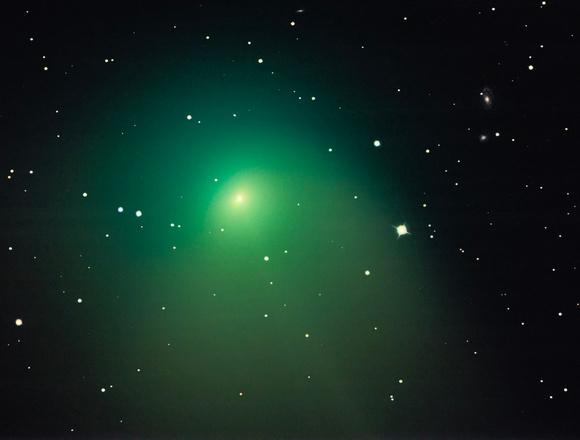The Green Comet (C/2022 E3 ZTF)
The Green Comet (C/2022 E3 ZTF)
Comet C/2002 E3 (ZTF) in RGB - Jan 29th 2023
Planewave CDK12.5, AIS2600MC, A-P 1100 GTO AE
(25 x 120s exposures, Bin 1x1, Gain 100)
(93 x 30s exposures, Bin 1x1, Gain 100)
(200 x 8x exposures, Bin 1x1, Gain 100)
Total Integration Time = 2 hours
Comet C/2022 E3 (ZTF) was discovered in March 2022 at the Zwicky Transient Facility. It reached perihelion on January 12 (1.11 AU), 2023 and was closet to the earth (0.28 AU) on Feb 1.
The comet is being popularly dubbed the green comet for reasons obvious in this close-up image of its head. This colour is due to the concentration of C2 (diatomic carbon with quadruple covalent bonds?) and cyanogens (double cyanide groups), both of which are chemically unstable on earth - but apparently common in comets (I suspect due to a lack of reducing agents or activation energy?). At any rate, both "gasses" are green. Interestingly in 1910 the spectrographic discovery of cyanogens in Halleys comet led New Yorkers to wear gas masks on the streets in fear that passing through the comet's tail could poison our atmosphere.
Other than being green, the Oort cloud comet is interesting (at least to me) from the standpoint that it is non-periodic. I am not sure if this means it will never be seen again, or no-one knows when it will be seen again.
This image was produced by first creating an all-sky model with my mount, and then using the mount / JPL Horizons facility to download a position v time table. This tracked the comet extremely well, allowing for long tracking time, even at 2540mm focal length.
The awkward rendition of the stars was partly caused by my obsession to also insert static stars AND galaxies into the final image. Note that AI star removal routines don't recognize galaxies as stars, and must be "manually" inserted into the final image. I would have done a better job on the stars, if I hadn't been greedy with the galaxies.


